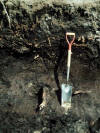 Freetown Soil
Freetown SoilPLYMOUTH COUNTY, MASSACHUSETTS SOIL SURVEY UPDATE
Freetown Soils: Very deep, nearly level, very poorly drained organic soil formed in more than 51 inches of highly decomposed organic material. Freetown soils are in depressions, kettle holes, along streams and rivers or on flat, level areas of uplands or outwash plains.
Link
to Official Series Description
Freetown Pedon Description 2305501
Freetown Pedon Description 2305502
Freetown Pedon Description 2305202
Map
Unit (s): 052, 53, 55
Map
Phases:
Taxonomic
Classification: Dysic mesic, Typic Medisaprists.
Drainage
Class: Very poorly drained.
Parent
Material: Freetown soils formed in greater than 51 inches of
organic material.
Permeability:
Moderate or moderately rapid.
Available
Water Holding Capacity: High.
Soil
Reaction (pH): pH is less than 4.5 in 0.01 molar calcium
chloride.
Depth
to Bedrock: Greater than 65 inches.
Seasonal
High Watertable: Depth: +3.0 to 0.5 feet below the
surface.
Type: Apparent.
Months: January to December.
Hydrologic
Group: D.
Hydric
Soil: Yes.
Flooding/Ponding
Potential: Frequency and Type: Frequently ponded.
Duration and Months: Long to very long, January to
December.
Map unit 53 is ponded up to 6 feet throughout the year.
Map unit 55 is periodically flooded throughout the year
for cranberry management practices.
Potential
Inclusions: Swansea, Scarboro, Berryland, and Sippican soils
are similar inclusions. Poorly drained Wareham, Saugatuck and
Pipestone soils are on higher elevations.
Soil Suitability:
Agriculture: Poorly suited for most agricultural uses mainly due to wetness. Map unit 55 is important/unique farmland for cranberry production.
Woodland: Poorly suited due to wetness. Freetown soils have a sever limitation for tree throw hazard.
Development: Poorly suited due to seasonal high watertables at or near the surface for prolong periods of time. Organic layers have very low strength and should be removed to support loads.
Back to
Homepage
Back to
Legend
Back to
Cranberry Bed Soil Map Unit